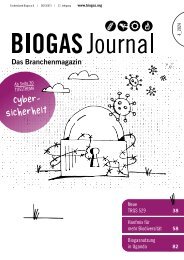You also want an ePaper? Increase the reach of your titles
YUMPU automatically turns print PDFs into web optimized ePapers that Google loves.
English Issue<br />
Biogas Journal<br />
| <strong>Autumn</strong>_<strong>2017</strong><br />
Biogas plant in<br />
Osorno, Los Lagos.<br />
in Chile (National Energy Commission, CNE, <strong>2017</strong>).<br />
This shows that the technology is still relatively unknown<br />
in Chile, which explains why around 19 biogas<br />
projects were abandoned for various reasons. These<br />
reasons include the complexity of their operation, poor<br />
design, and lack of trained personnel for the operation<br />
and maintenance of the plants, which in the short term<br />
discourages users due to constant breakdowns.<br />
The dairy sector of southern Chile is a reflection of what<br />
is happening at the national level. According to a survey<br />
conducted by the Centre for Innovation and Promotion<br />
of Sustainable Energy (CIFES), the Agricultural Research<br />
Institute (INIA) and UNIDO (2016), there are<br />
14 biogas plants installed in dairy farms throughout<br />
Los Ríos and Los Lagos. They are all small but only<br />
six are in operation. The cattle farms surveyed have<br />
between 27 and 400 milking cows and treat from 0.26<br />
to 8.92 m3/day of slurries as their only inflow.<br />
Most of the digestion technologies used in the dairy<br />
sector are covered lagoons with no heating or stirring<br />
system, with an average operating temperature of 13°<br />
C. This, added to the low content of organic matter in<br />
the slurry, results in a relatively low amount of biogas.<br />
Therefore, it is mainly used for heating water to be used<br />
in feeding the calves or cleaning milking equipment. To<br />
a lesser extent, there are new projects involving electricity<br />
generation and co-generation but with very low<br />
efficiency, mainly because of the lower efficiency of<br />
transforming biogas into electricity.<br />
Programme to promote biogas in dairy<br />
farms across the country<br />
Chile made a formal commitment to gradually increase<br />
the share of renewable energy in the energy mix some<br />
years ago. This is mainly due to the requirement for<br />
higher energy self-sufficiency at reasonable costs and<br />
compliance with the agreements on climate change.<br />
This objective has been met successfully in the large<br />
electric generation projects segment, mainly with largescale<br />
photovoltaic and wind power systems. However,<br />
the same growth has not been apparent on a smaller<br />
scale with projects for energy self-consumption.<br />
There are certain barriers in the self-consumption segment,<br />
which hinder the widespread use of renewable<br />
technologies and biogas in particular. These barriers<br />
relate to: a) lack of information and user distrust of<br />
this technology; b) high investment costs and limited<br />
access to traditional financing sources; c) absence or<br />
limited presence of local suppliers; and d) high dispersion<br />
of costs, among other things. In the case of biogas,<br />
the complexity of design and operation of the projects<br />
add to the previous barriers, which makes it necessary<br />
to have specially trained personnel for this purpose.<br />
Therefore, the necessity of creating a programme to address<br />
these barriers and questions was clear, in order<br />
to promote this technology as an energy source for selfconsumption<br />
and as a GHG mitigation tool. The dairy<br />
sector was considered an adequate starting point, since<br />
there are a good number of small and medium-sized<br />
producers concentrated in a relatively limited territory,<br />
where a substrate with potential to produce biogas is<br />
generated on a daily basis.<br />
In September 2014, the project “Promoting the development<br />
of biogas energy amongst selected smalland<br />
medium-sized agro-industries” was launched with<br />
funding from the Global Environment Facility (GEF).<br />
This was implemented by the Ministry of Energy together<br />
with the United Nations Industrial Development<br />
Organization (UNIDO) as the implementing agency.<br />
The project focuses on small and medium-sized dairy<br />
farms (100 to 500 milking cows) from Los Rios and Los<br />
Lagos regions, and defines activities for achieving three<br />
main components. The first one is to produce valuable<br />
information and strengthen the regulatory framework<br />
for biogas; the second to create technical capacities<br />
in those in charge of operating and developing biogas<br />
projects; and a third component to develop a portfolio<br />
of operating projects that allows for the mitigation of<br />
greenhouse gases and to continue producing specialized<br />
knowledge in the field.<br />
A relevant milestone to date is the technical preliminary<br />
feasibility studies conducted on 57 small and<br />
medium-sized dairy farms, which did not show very<br />
favourable results at first. Although it is estimated that<br />
these projects could mitigate an average of 80% of<br />
the CO 2<br />
eq emissions of dairy farms, none of the cases<br />
was proven profitable regarding energy saving or sales.<br />
44

















